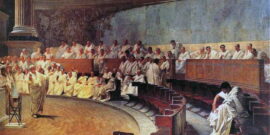The Supreme Court Confronts the Administrative State
It could be a coincidence—or it could foretell an historic Supreme Court term. The Court has now accepted two cases for this term that could threaten the essential legal underpinnings of the federal administrative state.
The first is American Hospital Association v. Becerra, in which the plaintiff questions the Chevron doctrine—a rule fashioned by the Supreme Court itself in 1984 that requires lower federal courts to defer to administrative agencies’ interpretation of their delegated authorities, where the statute is ambiguous and the agency’s decision is “reasonable.” Under this rubric, lower federal courts have given administrative agencies wide leeway to interpret the scope of their authority.
The second case, which has received less attention, is West Virginia v. Environmental Protection Agency, in which the state is challenging EPA’s authority to impose restrictions on the emission of greenhouse gases under the Clean Air Act. West Virginia has a number of objections to the EPA’s actions, but one of them raises a constitutional issue known as the nondelegation doctrine, which was last invoked by the Supreme Court in 1935. This holds that under the Constitution’s separation of powers, Congress may not delegate any of its legislative authority to agencies of the executive branch. Accordingly, if Congress gave so much discretion to the EPA in the Clean Air Act that the agency could create what was in effect a new law—without congressional authorization—the Act would violate the nondelegation doctrine.
Thus, while Chevron has largely been used to expand the authorities of administrative agencies over time—with the courts providing generous readings for agencies’ claims of authority under ambiguous laws—the nondelegation doctrine has the potential to narrow the range of administrative activity by requiring Congress to enact more tightly drawn legislation. If the Court should weaken or eliminate Chevron, and re-invigorate the nondelegation doctrine, it would mean—in a single term—a significant narrowing of administrative state authority and an historic shift in the Court’s jurisprudence away from precedents initially established in and after the New Deal.
Prior cases have laid the groundwork for changing the Court’s view of both doctrines.
Taking Chevron first, many commentators have noted that the lower federal courts have been generous in accepting claims by administrative agencies that their statutory authority is ambiguous and their interpretation of that authority is reasonable. As the Wall Street Journal has pointed out “By one estimate, appellate courts agree with an agency’s judgment that a statute is ambiguous 70% of the time, and then 94% of the time uphold [the agency’s] interpretation.” The result has been a continuing expansion of the powers of administrative agencies, and an invitation to Congress to enact ambiguous laws. This in turn has enabled Congress to avoid making difficult legislative decisions by granting unspecified powers to administrative agencies.
The first serious crack in the Chevron wall came in the 2013 case City of Arlington v. FCC. There, Chief Justice Roberts, together with Justices Alito and Kennedy, dissented from a majority opinion in support of Chevron written by Justice Scalia.
This in itself was a major change in the Court’s attitude toward Chevron, but it was followed in 2015 by Perez v. Mortgage Bankers Association, in which Justice Scalia—long the Court’s strongest supporter of Chevron—formally recognized that the Administrative Procedure Act (APA) requires the reviewing court—and not the administrative agency—to interpret the meaning of a statute. In other words, the courts, and not the agencies, are the final arbiters of an agency’s authority. As the Chief Justice said in City of Arlington, “We do not leave it to the agency to decide when it is in charge.”
Now the Court has the Becerra case before it, with the possibility of weakening or even eliminating the Chevron doctrine by re-asserting the authority of the federal courts under the APA. The issue is whether Health and Human Services (HHS) has the power under Medicare to alter the reimbursement rates that hospitals receive for outpatient drugs. The applicable law specifies two reimbursement methods—hospital acquisition costs and average drug prices—but HHS claims that it has authority to “adjust” reimbursement rates as necessary despite the language of the statute.
Although the district court agreed with the American Hospital Association, the DC Court of Appeals overruled the lower court and found that HHS was entitled to deference under Chevron that would allow it to vary the reimbursement for hospitals.
The Supreme Court has a range of possible responses. One, of course, is to agree with the DC Circuit, but that seems unlikely. Four justices must agree to take a case, so four justices already think the DC Circuit’s decision is questionable. On the other hand, following the APA, the Court might want to place its weight behind a district court that enforced the specific language of the statute. This would weaken Chevron. Further, the Court might want to restate or re-emphasize what the Chief Justice said in City of Arlington, “We do not leave it to the agency to decide when it is in charge.” A statement like this could put an end to Chevron.
What the Court says this term on either Chevron or the nondelegation doctrine, or both, could reverberate for years to come when courts consider the scope of statutes that confer authority on the agencies of the administrative state.
West Virginia v. EPA could also be decided on several grounds, but many on the left have expressed concern that the Court might invoke the nondelegation doctrine to overturn the DC Circuit’s decision. Because this doctrine grows out of the constitutional separation of powers, many constitutional scholars believe that the Court should step in when Congress seems to have given the agencies the power to make new rules binding on the private sector instead of merely interpreting what Congress has enacted.
In 2018, the Court took a case—Gundy v US—solely for its nondelegation implications. But at the time of argument, because Justice Kavanaugh had not yet been sworn in, there was no majority opinion. Now, with a bench of nine, a majority opinion is possible.
To be sure, West Virginia could be decided on non-constitutional grounds. The case arose out of the Clean Power Plan (CPP), pressed by President Obama in 2015. The plan, ultimately adopted by EPA, was intended to use the Clean Air Act as a vehicle for reducing carbon emissions by coal and gas-powered electric generating plants, even though Congress had never specifically given it that authority for stationary plants. Eventually, under new leadership in the Trump administration, EPA decided that it did not have the authority it was asserting in the CCP and rescinded the plan in 2019. However, in January 2021, the DC Circuit issued a 2-1 decision vacating the rescission of the CPP and holding that the EPA did in fact have the authority to issue the CPP, and even to do more than the CPP had mandated.
West Virginia and several other states appealed that decision and the Supreme Court granted certiorari to review the DC Circuit’s opinion.
Thus, there are a number of possible positions the Supreme Court could take. It could of course find that the EPA had authority to pursue the Clean Power Plan, but this is unlikely. The Court had already issued a temporary stay on CCP implementation in 2016, after 27 states appealed. To issue that stay, at least four justices had to agree that the regulation exceeded the EPA’s statutory authority, and the Court’s composition is more conservative today than it was in 2016.
Congress has never rewritten the Clean Air Act to address concerns about climate change and greenhouse gases; the law was enacted before climate change was an issue. Today’s Court could look carefully at the EPA’s statutory authority and decide simply to overrule the DC Circuit’s opinion.
The Court also could use this case, and the DC Circuit’s broad view of EPA’s authority under the Clean Air Act, as an example of a statute that unconstitutionally delegates legislative authority to an administrative agency, reviving the nondelegation doctrine for the first time since 1935.
What the Court says this term on either Chevron or the nondelegation doctrine, or both, could reverberate for years to come when courts consider the scope of statutes that confer authority on the agencies of the administrative state.



